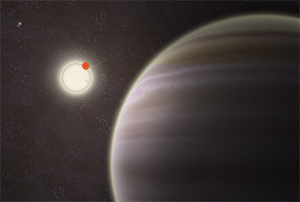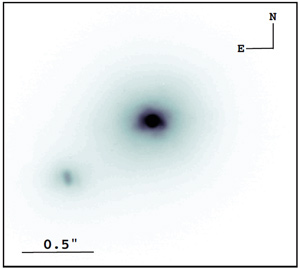 A new exoplanet - a planet outside our own solar system - has been found, and it’s pretty cool for two reasons: it was found by amateur planet hunters, and it’s in a four-star system!
A new exoplanet - a planet outside our own solar system - has been found, and it’s pretty cool for two reasons: it was found by amateur planet hunters, and it’s in a four-star system!
OK, first, the planet: called PH-1, it’s bigger than Earth, about six times our radius, or about half the diameter of Jupiter. The mass isn’t well known, but may be as high as 170 times our own mass, though far more likely it’s closer to 20 - 50 times our mass. That makes it closer physically to Uranus and Saturn than Earth, so it’s likely a gas giant. It’s also hot, with a probable cloud-top temperature of 400+ Celsius (800+° F). Even if it has Earth-sized moons they’re likely to be too hot to be hospitable. And since it’s 5000 light years away, we’re not headed there any time soon, anyway.
But the more interesting thing about this planet is its host stars: PJK-1 orbits a binary star, two stars that orbit each other (like Tatooine, if you like). Six other planets are known to orbit binary stars, but PH-1 is even cooler: the binary star is itself orbited by another binary pair much farther out, making it the first planet found in a four-star system.
So we have two stars orbiting each other, orbited by a planet, and also orbited by two other stars which orbit each other. Yegads.
But it gets better yet. This planet was not found by professional astronomers! It was discovered by two amateurs who participate in the Planet Hunters program. This project was started by astronomers using the orbiting Kepler Observatory, designed to stare at 100,000 stars and look for dips in light from them as any potential planets orbiting them block their light. These transits show up in graphs of the stars’ brightnesses, and actually our human eyes and brain are pretty good at picking them out. Planet Hunters puts Kepler data online for anyone to go in and poke around.
 The two citizen scientists, Kian Jek and Robert Gagliano, are listed as authors on the scientific paper recently published. I love this: the digital nature of these data make it far, far easier to analyze the science than it was in the past, and also easier to get the data out to people. Because of this, we have an explosive growth in these kinds of projects. Planet Hunters is great, but then so is Galaxy Zoo, Moon Mappers, Ice Hunters, and so many others. You can find several of these collected at the CosmoQuest website.
The two citizen scientists, Kian Jek and Robert Gagliano, are listed as authors on the scientific paper recently published. I love this: the digital nature of these data make it far, far easier to analyze the science than it was in the past, and also easier to get the data out to people. Because of this, we have an explosive growth in these kinds of projects. Planet Hunters is great, but then so is Galaxy Zoo, Moon Mappers, Ice Hunters, and so many others. You can find several of these collected at the CosmoQuest website.
And a word about this new planet; this isn’t the first planet found by Planet Hunters, but it’s the first ever found in a quaternary star system. In the image here, the central binary is the big blob in the middle, and the second pair the elongated double-blob to the lower left. The planet is far too close to the middle stars to be seen here - its orbit is smaller than Earth’s around the Sun, far smaller than a pixel in this image at that distance.
The central binary is made up of a bluish star hotter and brighter than the Sun, and one that’s cooler, fainter, and redder. The second binary is made of one star much like the Sun, and another dinky red one. Their distance from the planet - about 150 billion kilometers - means they’d both still be very bright, with the brighter of the two almost as bright as the full Moon as seen from Earth. What a sight that would be! The second star would be hard to pick out in the glare of the other, but with binoculars you could spot it.
Not that anyone could, since the planet is hot enough to melt tin and assuming it had a solid surface to start with. Still though, it’s not hard to imagine a smaller planet orbiting that binary farther out, in a cooler, more life-friendly position. And we know such a planet exists; Kepler recently revealed a planet orbiting a binary star at the right spot to have liquid water as well. Like PH-1, that planet is probably a gas giant, but it might have big moons…
And this shows us once again that nature just loves to make planets, even ones in really weird places that at first may seem inhospitable for planet formation. But there it is.
Every time we find a strange planet like this, it fills me with hope that the ultimate goal of this work is close: finding an Earth-sized planet in the habitable zone of another star. We’re getting closer every day to that announcement, I think. In fact, I strongly suspect that planet is already sitting in the Kepler data, faint and hard to tease out, but just waiting to be found.
Go sign up for Planet Hunters. Maybe you’ll be the one to find it.
Image credits: Haven Giguere/Yale; Keck Observatory/Megan E. Schwamb et al.
Related Posts:
- Two exoplanets discovered by “citizen scientists”
- YOU can find extrasolar planets
- Astronomers discover a wretched hive of scum and villainy (and the followup, Exoplanet news Part 4: More wretched hives of scum and villany)
- Kepler finds a planet in a binary star’s habitable zone